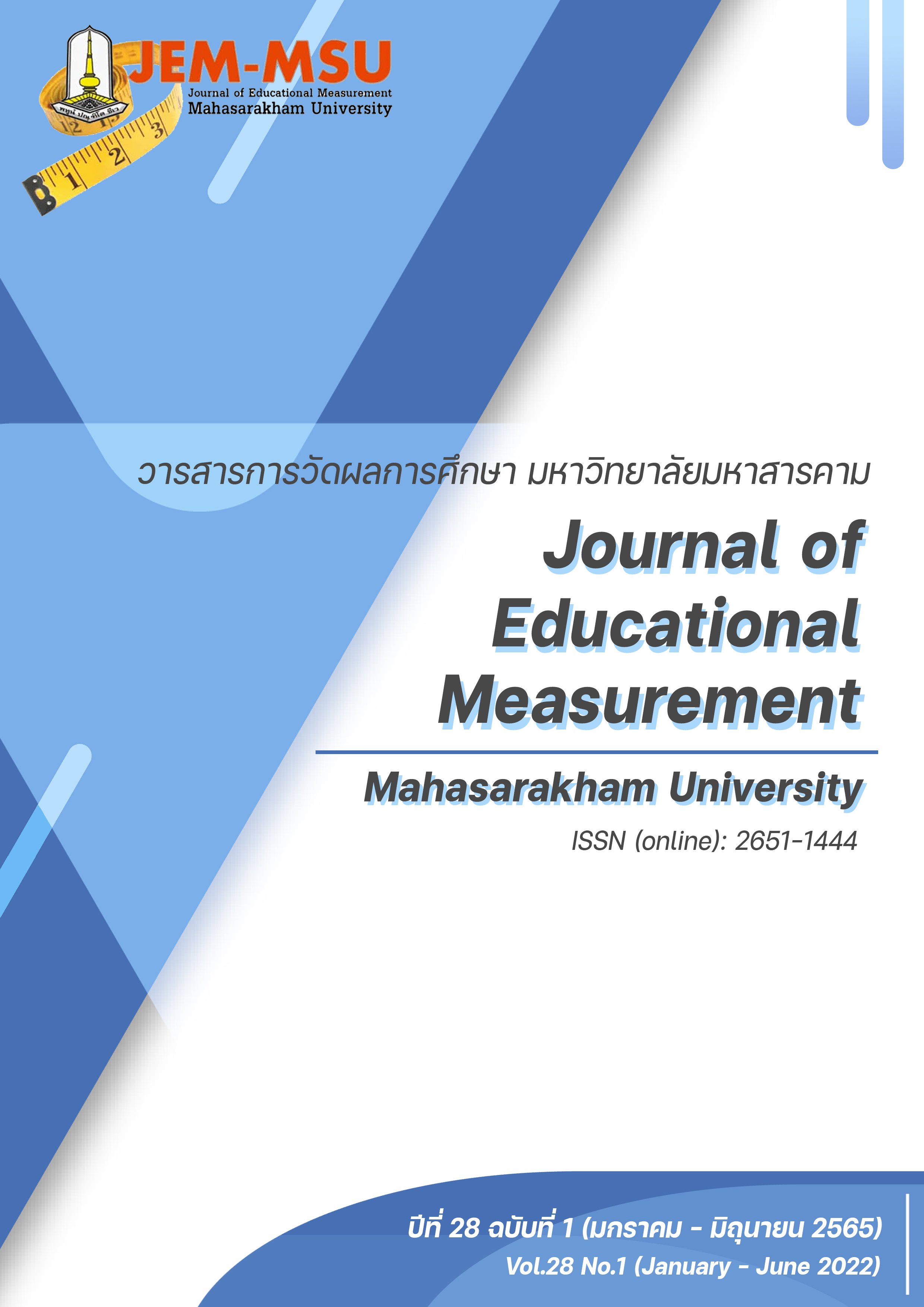Test of Gender Invariance of the E-learning Acceptance Scale of College Students during the COVID-19 Pandemic
Main Article Content
Abstract
This research aimed to 1) assess the reliability, construct validity of the E-learning acceptance scale and 2) test gender invariance of the E-learning acceptance scale. The sample consisted of 400 students of the Faculty of Management Science of Bansomdejchaopraya Rajabhat University; power analysis for structural equation modeling was used to determine the sample size. Stratified random sampling based on gender using secondary dataset of e-learning effectiveness evaluation was used. Frequency, percentage, the mean and standard deviation, Pearson’s correlation coefficient and multi-group confirmatory factor analysis were used to analyze the data.
The results yielded that 1) the E-learning acceptance scale was composed of 3 constructs: perceived ease of use, perceived usefulness and intention to use e-learning, with high reliability of 0.91, 0.92 and 0.93 accordingly. The confirmatory factor analysis demonstrated that the measurement model labeled a high quality of construct validity (2=32.93, df=24, p-value=0.11, CFI=.99, RMSEA=0.03), and 2) the E-learning acceptance scale featured strict gender invariance.
Article Details

This work is licensed under a Creative Commons Attribution-NonCommercial-NoDerivatives 4.0 International License.
The content and information contained in the published article in the Journal of Educational Measurement Mahasarakham University represent the opinions and responsibilities of the authors directly. The editorial board of the journal is not necessarily in agreement with or responsible for any of the content.
The articles, data, content, images, etc. that have been published in the Journal of Educational Measurement Mahasarakham University are copyrighted by the journal. If any individual or organization wishes to reproduce or perform any actions involving the entirety or any part of the content, they must obtain written permission from the Journal of Educational Measurement Mahasarakham University.
References
Aguilera-Hermida, A. P. (2020). College students’ use and acceptance of emergency online learning due to Covid-19. International Journal of Educational Research Open, 1, Article 100011. https://doi.org/10.1016/j.ijedro.2020.100011
Al-Azawei, A., Parslow, P., & Lundqvist, K. (2017). Investigating the effect of learning styles in a blended e-learning system: An extension of the technology acceptance model (TAM). Australasian Journal of Educational Technology, 33(2), 1-23.
Al-Okaily, M., Alqudah, H., Matar, A., Lutfi, A. A., & Taamneh, A. (2020). Impact of Covid-19 pandemic on acceptance of elearning system in Jordan: A case of transforming the traditional education systems. Humanities and social Sciences Review, 6(4), 840-851.
Boomsma, A., & Hoogland, J. J. (2001). The robustness of LISREL modeling revisited. Structural equation models: Present & future. A Festschrift in honor of Karl Jöreskog, 2(3), 139-168.
Davis, F. D., Bagozzi, R. P., & Warshaw, P. R. (1989). User acceptance of computer technology: A comparison of two theoretical models. Management science, 35(8), 982-1003.
Davis, F. D. (1989). Perceived usefulness, perceived ease of use, and user acceptance of information technology. MIS quarterly, 13(3), 319-340.
Hair, J. F., Black, W. C., Babin, B.J., & Anderson, R. E. (2010). Multivariate Data Analysis (7th ed.). Pearson Education.
Hirschfeld, G., & Von Brachel, R. (2014). Multiple-Group confirmatory factor analysis in R-A tutorial in measurement invariance with continuous and ordinal indicators. Practical Assessment, Research & Evaluation, 19, Article 7. https://doi.org/10.7275/qazy-2946
Kline, R. B. (2011). Methodology in the Social Sciences.Principles and practice of structural equation modeling (3rd ed.). Guilford Press.
Milfont, T. L., & Fischer, R. (2010). Testing measurement invariance across groups: Applications in cross-cultural research. International Journal of psychological research, 3(1), 111-130.
Ong, C.S. and Lai, J.Y. (2006) Gender Differences in Perceptions and Relationships among Dominants of E-Learning Acceptance. Computers in Human Behavior, 22, 816-829. http://dx.doi.org/10.1016/j.chb.2004.03.006
Preacher, K. J., & Coffman, D. L. (2006). Computing power and minimum sample size for RMSEA [Computer software]. http://quantpsy.org
Schreiber, J. B. (2017). Update to core reporting practices in structural equation modeling. Research in Social and Administrative Pharmacy. 13(3), 634-643.
Sukendro, S., Habibi, A., Khaeruddin, K., Indrayana, B., Syahruddin, S., Makadada, F. A., & Hakim, H. (2020). Using an extended Technology Acceptance Model to understand students’ use of e-learning during Covid-19: Indonesian sport science education context. Heliyon, 6(11), Article e05410. https://doi.org/10.1016/j.heliyon.2020.e05410
Tarhini, A., Hone, K., & Liu, X. (2014). Measuring the moderating effect of gender and age on e-learning acceptance in England: A structural equation modeling approach for an extended technology acceptance model. Journal of Educational Computing Research, 51(2), 163-184.
UNESCO, (2020, May 3). COVID-19 Impact on Education. https://en.unesco.org/covid19/educationresponse.
WHO, (2020, October 12). Coronavirus disease (COVID-19). https://www.who.int/emergencies/diseases/novel-coronavirus-2019/question-and-answers-hub/q-a-detail/coronavirus-disease-covid-19
Zhu, N., Zhang, D., Wang, W., Li, X., Yang, B., Song, J., Zhao, X., Huang, B., Shi, W., Lu, R., Niu, P., Zhan, F., Ma, X., Wang, D., Xu, W., Wu, G., Gao, G.F., & Tan, W. (2020). A novel coronavirus from patients with pneumonia in China, 2019. New England journal of medicine, 382(8), 727-733.


